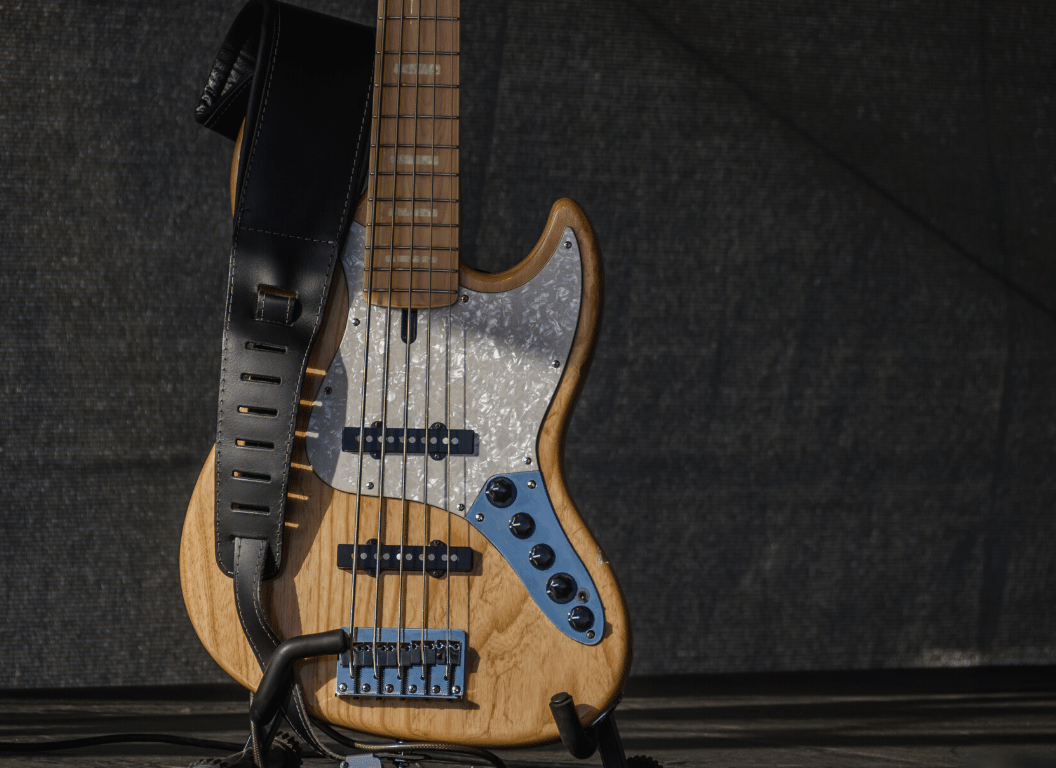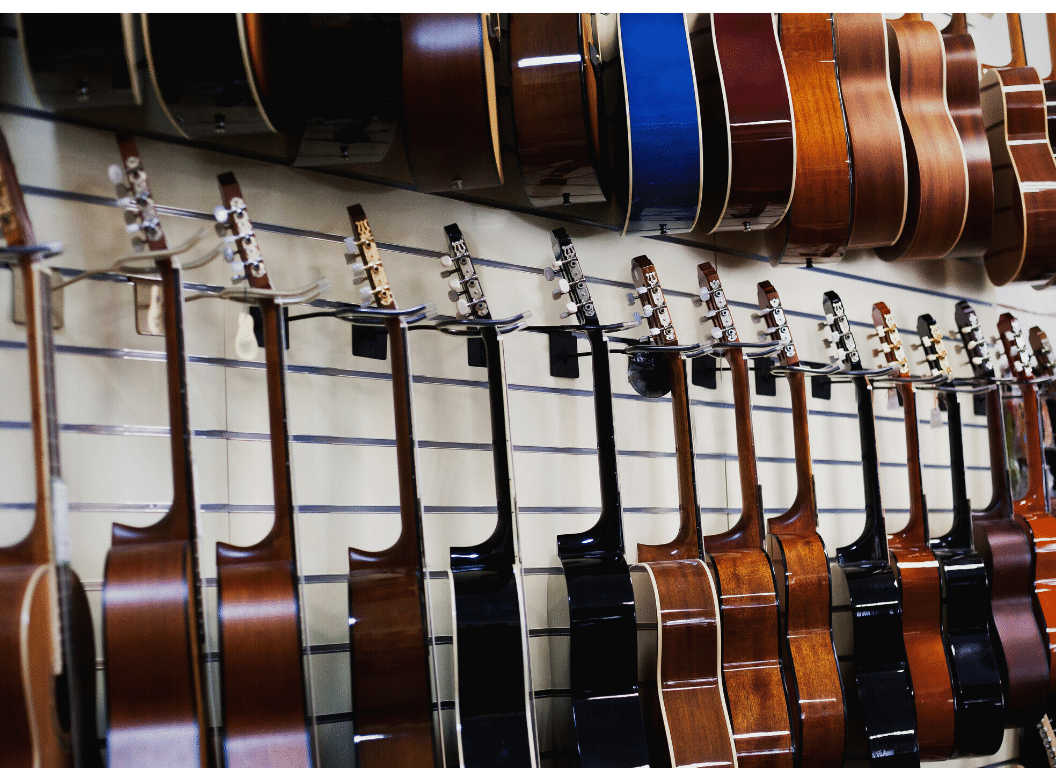Diving into the world of music with the desire to strum those basslines can seem daunting at first.
Yet, with the right direction and dedicated practice, your voyage into mastering the bass guitar can swiftly transform from impossible to achievable.
This guide focuses on providing you, a beginner, with clear instructions, practical tips, and essential information for quick learning.
Whether you are a complete novice or have a bit of experience, there is something relevant for you here.
Our objective is to make your engagement with the bass guitar less intimidating and more enjoyable.
So, spare no further moments and let’s embark on this exciting musical journey.
Table of Contents
- How To Play Bass Guitar? The Ultimate Beginner’s Guide To Learn Fast
- Understanding the Basics of Bass Guitar
- Step by Step Guide to Properly Hold a Bass Guitar
- The Anatomy of the Fretboard: An Insight
- How to Perfectly Pluck the Strings?
- How to Perfectly Pluck the Strings?
- Importance of Daily Practice and Useful Exercises
- Why Use Online Tutorials or Hire a Professional Tutor?
- Learning the Language of Music: How to Read Tablature and Sheet Music
- Exploring Various Genres for a Versatile Bass Playing Style
- Key Differences Between Different Types of Bass Guitars
- The Bottom Line
How To Play Bass Guitar? The Ultimate Beginner’s Guide To Learn Fast
To play the bass guitar, start by learning the basics such as holding the instrument properly, understanding the fretboard, and knowing how to pluck the strings perfectly. Practice is paramount, thus commit to daily exercises like scales and chords, and utilize online tutorials or a tutor to enhance your skills. Finally, learn to read tablature and sheet music to broaden your repertoire and explore different genres to improve your versatility as a bassist.
Indeed, beyond the foundational principles of playing the bass guitar, this guide will delve into other critical aspects that can enhance your playing capacity exponentially.
For instance, understanding the role of a bassist in a band or orchestration, getting familiar with pedal effects and how they can transform your sound, and ways to maintain your instrument for maximum longevity and performance.
We will also touch on some practical advice and strategies suitable for those who might be considering the bass guitar as more than just a hobby but a potential career path.
By continuing with this comprehensive guide, you are equipping yourself with not just the knowledge to start, but the essential skills that could dramatically shape your journey as a bass guitarist.
Understanding the Basics of Bass Guitar
The bass guitar is an incredible instrument, providing the backbone and foundation to many different kinds of music.
Fundamental to its role in rhythm and harmony, the bass guitar contributes a unique and essential dynamic to collective melodies.
For those entirely new to the world of bass guitar, gaining a basic understanding of this instrument and its role can be quite intriguing.
Before delving into the various aspects of playing techniques, it’s integral to comprehend how the bass guitar functions in a band and music overall.
Role of Bass Guitar in a Band
The bass guitar acts as the bridge between the percussion and the melodic instruments in a band, weaving a binding force that holds the melody and rhythm together.
It commands a significant role in establishing the rhythm and the progression of chords.
Almost stealthily, the bass guitar directs your subconscious foot-tap and reflects the mood of the song.
The well-articulated rhythm supports the lead instruments and strengthens the overall structure of music.
The true magic of the bass guitar lies in its synchronicity with the rhythm of the drum and blending-in with the melody of the song.
Almost stealthily, the bass guitar directs your subconscious foot-tap and reflects the mood of the song.
This underlines the subtle control the bass guitar wields over the entire performance, often understated but profoundly impactful.
It is no exaggeration, therefore, to say the bass guitar is the ‘heartbeat’ of a band.
Essential Components of a Bass Guitar
The bass guitar comprises multiple components, each adding to its unique structure and sound quality.
The neck of the bass guitar, accommodating the fretboard, is vital in maneuvering the tones and reaching the higher notes.
Equally important is the headstock; located at the very end of the neck, it houses the tuning pegs and is crucial for pitch adjustments.
The body of the bass guitar bears the pickups and controls for volume and tone.
Also significant are the strings, typically four in number, though five and six-string basses are also available for experienced players.
Each of these elements plays an equally intricate role in the ultimate sound production of this instrument.
Also significant are the strings, typically four in number, though five and six-string basses are also available for experienced players.
Understanding each component is essential as it contributes to the functionality and sound of the bass guitar.
Such comprehension will also help during maintenance and repair or even when looking to buy a new bass guitar.
For those wanting to learn how to navigate the fretboard of a bass guitar, this is a beneficial resource.
The video provides a four-step method to familiarize oneself with the fretboard, which is crucial for mastering the bass guitar.”
Step by Step Guide to Properly Hold a Bass Guitar
Understanding how to properly hold your bass guitar is a fundamental step in mastering the instrument.
Incorrect posture and grip can not only affect your performance, but also lead to physical discomfort.
The Standing Position
The standard and most common way of holding a bass guitar is in the standing position.
To do this correctly, you will need a guitar strap which helps distribute the weight of the instrument across your shoulder and back.
Adjust this strap so the bass hangs around your waist and the headstock is just above your shoulder level.
It’s important that when you let go, the guitar stays in the same position, allowing your hand to move freely along the fretboard.
Remember, the key is to find a comfortable height that doesn’t strain your wrist or shoulder.
The key is to find a comfortable height that doesn’t strain your wrist or shoulder.
This suggests that comfort is a primary factor in determining how high or low your guitar should be.
Avoid forcing your body into unnatural positions and experiment with different heights until you find the most comfortable one.
The Sitting Position
Another common way of holding a bass guitar is in the sitting position.
This technique might be more suitable for beginners as it offers more stability and control.
Place the curve of the bass on your right leg (if you’re right-handed) and let it lean against your torso, with the back touching your chest.
Ensure that your right arm lays over the body of the guitar, allowing your hand to naturally fall onto the strings, while your left hand should be free to navigate the fretboard.
Again, comfort should determine the exact position.
Comfort should determine the exact position.
Just like in the standing position, finding a comfy place for your guitar when sitting is crucial.
Whether you’re practicing or performing, the primary focus should be on playing the instrument rather than battling with uncomfortable positions.
The Anatomy of the Fretboard: An Insight
Understanding the anatomy of the fretboard is a significant step towards becoming a competent bass player.
It is the tool that converts string vibrations into audible sound, and knowing how it works is crucial.
Anatomy of a Fretboard
The fretboard, also known as the fingerboard, is the long, flat piece on the front of the guitar where you press down to change the pitch of the strings.
It is usually made of hardwood and has several metal strips (frets) running across it, which divide the board into sections.
These frets act as guides for placing your fingers and create different notes when a string is pressed against them.
These frets act as guides for placing your fingers and create different notes when a string is pressed against them.
This demonstrates how the frets’ roles are essential to note creation.
In learning your guitar’s fretboard, you’re essentially understanding the language of music through your bass guitar.
The Importance of Notes and Scales on a Fretboard
Apart from frets, understanding notes and scales on a fretboard is also crucial for any bass player.
The positioning of the notes on a bass guitar fretboard allows the guitarist to know which note they are playing when they press down a string.
The varying musical scales show the sequences of notes that contribute to creating different melodies and harmonies.
Understanding this enables you to confidently move around the fretboard and play melodies and riffs correctly.
So, learning both the layout and the application of the fretboard enables a bass guitarist to be versatile and competent in their playing.
Learning both the layout and the application of the fretboard enables a bass guitarist to be versatile and competent in their playing.
This underscores the crucial role of the fretboard – it is the very catalyst for versatility and competency within any bass player’s skill set.
Indeed, a deep understanding of the fretboard leads to a great improvement in playing skills, and ultimately, a more rounded musician.
How to Perfectly Pluck the Strings?
Perfect plucking technique is pivotal to achieving a smooth, resonant sound on your bass guitar.
Correct Finger Placement
The first step is to ensure correct finger placement.
Your plucking fingers (usually the index and middle finger) should strike the strings in the same place every time to achieve a consistent sound.
Your plucking fingers should strike the strings in the same place every time to achieve a consistent sound.
Also, by regularly practicing the plucking of the strings, you can help achieve a steady and even bass tone.
Incorporating Wrist Movement
Effective plucking also involves wrist movement.
Head bobbing and finger flexing might look cool, but the real movement happens in the wrist.
After striking the string, your wrist should naturally pivot back to the neutral position, ready for the next note.
Remember, the goal is to create the richest sound possible, and perfecting your string plucking technique is a crucial aspect of that.
Have a systematic approach and give due attention to every detail, and soon, you’ll see your efforts bearing fruit in the form of beautiful music.
How to Perfectly Pluck the Strings?
Understanding the Plucking Technique
To play the bass guitar with finesse, plucking right is of utmost importance.
It’s a basic technique, but one that significantly impacts the sound.
The predominant method is the “fingerstyle” or “finger plucking,” where you use the index and middle fingers of your right hand (assuming you’re right-handed).
The use of this technique ensures a smooth, rhythmic, and rich sound.
To play the bass guitar with finesse, plucking right is of utmost importance.
This cannot be overemphasized, as the way you pluck the strings can make or mar your overall bass playing experience.
Mastery of this technique greatly enhances your versatility and creativity as a bass guitarist.
The Fingerstyle Technique Explained
The fingerstyle technique, also known as ‘alternate fingering’, is like the bass guitars’ natural plucking method.
It involves using the index and middle fingers alternatingly in a ‘running man’ motion.
Precision, rather than speed, is key in producing the best sound when employing this technique.
Mastery of this technique greatly enhances your versatility and creativity as a bass guitarist.
Your fingers play a huge role in shaping the tone and rhythmic flow of the bass sound.
Thus, it’s important to focus on your fingering technique and continuously strive to improve it.
Tips to Perfect the Plucking Technique
For starters, begin with slow-paced songs that give you enough time to work on your plucking.
Once you have the basics right, you can shift to faster songs with more complex bass lines.
Also, ensure your hand position is correctly aligned _ your thumb should rest on the pickup or lowest string, while your fingers glide effortlessly across the strings.
Your fingers play a huge role in shaping the tone and rhythmic flow of the bass sound.
This statement reestablishes the role your fingers play in making your bass sound phenomenal.
Cultivating a consistent fingerstyle technique is crucial, and consistency here is key.
Practice Makes Perfect
Just like any skill, improving your plucking technique requires regular and intentional practice.
Make use of bass exercises specifically designed for the fingers, and don’t shy away from seeking professional help if you struggle.
The journey of bass playing is a marathon, not a sprint
Just like any skill, improving your plucking technique requires regular and intentional practice.
Given the instrumental role of the plucking technique in bass playing, it’s vital to commit to honing this skill.
And remember, there’s always room for improvement and learning, no matter what level you’ve reached.
Importance of Daily Practice and Useful Exercises
Daily practice is pivotal to mastering the bass guitar.
It’s the key to attaining proficiency and improving your skill set over time.
Think about it – you wouldn’t expect to become an amazing chef without cooking day after day, would you?
The same principle applies to musical instruments.
Building Muscle Memory
Firstly, daily practice helps to build muscle memory.
Playing the bass requires precise finger movement, and constant repetition enables your fingers to learn where they are supposed to be on the fretboard without conscious thought.
This muscle memory is crucial for developing speed and accuracy in your playing.
In essence, every time you practice, you’re training your fingers to be in the right place at the right time, making playing the bass feel like second nature.
Improving Timing
Another significant benefit of regular practice is improved timing.
Timing is the essence of music and rhythm.
Without proper timing, your music will sound off and disjointed.
Regular practice helps you maintain a steady beat and enhances your rhythmic accuracy.
To get better at this, you can practice along with a metronome or backing tracks which will also make your practice sessions more enjoyable.
Daily practice helps you maintain a steady beat and enhances your rhythmic accuracy.
This is of utmost importance as the bass is the backbone of any band or ensemble, laying down the rhythmic foundation.
Practicing daily will ensure that you can keep the timing and rhythm steady so that the rest of the band can follow suit.
Your bandmates will thank you.
Learning New Techniques
Moreover, daily practice allows you to explore new techniques and styles.
Every bass player has their unique playing style, and you can only develop yours if you spend time with your instrument.
Learning new techniques such as slap bass, fingerstyle, or playing with a pick can diversify your playing and open up a whole new world of music for you.
The more techniques you master, the more versatile and adaptable a bass player you’ll become.
By watching the embedded tutorial, you’ll delve deeper into the art of finding notes on the fretboard.
The practical demonstration will help you understand the points made in this article even better.
You will get invaluable tips and tricks on how to navigate the fretboard, improving your efficiency and playing style.
Useful Exercises
Lastly, having a set of useful exercises can make your practice sessions more productive.
Scales, arpeggios, and rhythm exercises are all great ways to improve your technique and musicality.
Most importantly, don’t forget to have fun.
Mix up your routine, try to learn songs that you love, and intersperse technical exercises with more musical ones.
After all, music is meant to bring joy!
Remember – practice makes perfect.
So pick up that bass and start playing!
Why Use Online Tutorials or Hire a Professional Tutor?
In the world of self-learning where YouTube and Udemy have changed how we learn music, you might ask why one needs online tutorials or a professional tutor for learning the bass guitar?
The Power of Structured Learning
Bass guitar is an intricate instrument which needs not only practical application but also theory.
Learning from random video sources might give you some tips and tricks, but it misses out on a coherent learning structure.
Online bass guitar tutorials or professional teachers follow a systematic curriculum which progresses from basic to advanced levels.
Their lessons are carefully structured in such a manner that it ensures thoroughness and understanding of bass guitar disciplines.
It is for this reason that they are often considered more efficient and effective compared to self-learning.
Online bass guitar tutorials or professional teachers follow a systematic curriculum which progresses from basic to advanced levels.
This statement stands proof to the fact that a structured curriculum facilitates better understanding and mastering of the instrument.
A tutor or online course ensures that all key concepts are covered in a systematic manner which also helps in building a strong foundation.
Feedback and Personalized Recommendations
Another important aspect is the provision of timely feedback and personalized recommendations that a professional tutor or an online tutor can provide.
This is something that is not possible with self-learning where correction of small mistakes are often overlooked.
Learning bass guitar is not just about playing the correct notes, it is also about the techniques of playing such as finger positioning, timing and groove.
Not having a tutor means these nuances will be missed out and unlearnt mistakes can become bad habits which would be hard to unlearn later.
Learning bass guitar is not just about playing the correct notes, it is also about the techniques of playing such as finger positioning, timing and groove.
The quote above emphasizes that understanding and playing an instrument is much more than just hitting the right notes.
Effective playing involves the right techniques and the ability to play in time with fluidity.
Having a tutor or taking an online course can provide the necessary guidance and feedback required to achieve these.
Learning the Language of Music: How to Read Tablature and Sheet Music
Being able to interpret tablature and sheet music is a crucial skill for any musician, including bass guitarists.
Tablature, also known as tabs, is a method of musical notation that illustrates where to place your fingers on the instrument’s fretboard, as opposed to the traditional staff notation.
Understanding Tablature
When you see tabs for a bass guitar, you’re going to notice horizontal lines representing each string.
The top line stands for the highest pitched string of the bass guitar, while the bottom line corresponds to the lowest.
Digits written on these lines show which fret to press down counts of playing that string.
The top line stands for the highest pitched string of the bass guitar
In the context of the bass guitar, this way of notation is used due to its simplicity and easy learning curve, especially for beginners.
Unlike classical sheet music, tabs do not provide information about rhythm or timing.
They are essentially instructions to place your fingers in the proper places at the right time.
Interpreting Sheet Music
Whereas, sheet music, a.k.a. staff notation, carries information about the pitch, timing, and rhythm of the song.
Differently from tabs, reading sheet music has a steeper learning curve.
But the advantage it has is disentanglement from any instrument, making it universal.
The line or space an emblem lies on dictates the note while its shape equips information about the length of the note.
The line or space an emblem lies on dictates the note.
Further, important components like scales, chord names, and dynamics can also be understood from the sheet music.
There is a learning curve, but the returns on understanding and interpreting sheet music are greatly rewarding, and it multiplies a bass guitarist’s musical language skills.
Tabs Vs Sheet Music
Therefore, knowing how to read both tablature and sheet music can immensely upgrade your flexibility and adaptability.
Generally, beginners start with learning tabs as they’re simpler, but learning to interpret sheet music in the long run is undeniably beneficial for every bassist, be it for classical pieces or modern songs.
While it might sound intricate and ambitious at the start, learning these skills is merely about patience, practice, and persistence.
This video can give you a great start on understanding the basic techniques of playing the bass guitar.
Effectively blending the set of instructions in the video with the theoretical knowledge of tablature and sheet music can certainly facilitate your journey of mastering the bass guitar.
Exploring Various Genres for a Versatile Bass Playing Style
Understanding different music genres and their associated basslines is essential for any ambitious bassist who wishes to foster a more versatile technique.
Generally, each musical genre requires a unique approach for bass playing. Therefore, broadening your genre knowledge helps enhance your flexibility when it comes to adapting to different styles of music.
From rock and jazz to funk and blues, there are quite a number of music genres for bass players to delve into.
Rock Music and Bass Guitar
Well known for its powerful, driving basslines, rock music offers thrilling opportunities for bass players.
Rock bassists often serve as the backbone of their bands, providing both rhythm and harmony.
With driving and dynamic playing styles, rock bass players often employ techniques such as fingerstyle and slap bass.
Rock bass players often employ techniques such as fingerstyle and slap bass.
This statement illustrates that rock bassists have a particular set of skills distinct from other styles.
Understanding these techniques can enhance a bass player’s ability to adapt to this genre.
Jazz and the Bass Guitar
Jazz, on the other hand, places a lot of emphasis on improvisation and is famed for its complex chord structures.
The jazz bassist’s role is often more fluid, often acting as both a rhythmic anchor and a soloist.
To play jazz effectively on the bass guitar, Bassists should practice complex chord progressions, improve their improvisation skills, and learn common jazz scales.
To play jazz effectively on the bass guitar, Bassists should practice complex chord progressions.
The quote emphasizes the need for continuous practice in mastering complex chord progressions associated with jazz.
It underscores the fact that improving your technique and practice is an essential part of becoming a good bass player in any jazz ensemble.
Funk Bass Technique
Funk is another genre that presents unique opportunities for bassists.
In funk music, the bass guitar often acts as the main instrument, driving the song with infectious and catchy basslines.
The funk bass technique often involves intricate rhythmic patterns, including syncopation, and techniques like slapping and popping.
When a bassist gains a comprehensive understanding of various music genres, they develop a richer repertoire and an ability to adapt to varied musical situations.
This, combined with constant practice and dedication, is guaranteed to propel any aspiring bassist to greater heights.
Key Differences Between Different Types of Bass Guitars
The complexity and richness of the music that we hear often boils down to the type of instrument played.
One such instrument is the Bass Guitar, which despite its simple look, comes in several varieties.
Understanding the key differences between different types of Bass Guitars can significantly enhance your playing experience, as each type caters to a different style and taste of music.
The Upright Bass
Also known as the Double Bass, the Upright Bass is the grandfather of the electric bass guitar.
These large, fretless instruments produce deep, warm tones and are especially respected in Jazz and Orchestral music.
Their size and weight, however, can make them rather challenging to play for extended periods.
These large, fretless instruments produce deep, warm tones and are especially respected in Jazz and Orchestral music.
Hence, mastering the Upright Bass requires a degree of commitment and physical endurance which makes it more suitable for serious and professional musicians.
The Electric Bass
Electric Bass guitars come in several varieties.
The most common type is the 4-string bass, tuned to the same pitches as the double bass, but in a more convenient, portable format.
Beyond that, there are 5-string and 6-string basses, which offer a wider range of notes.
Electric Bass guitars come in several varieties.
The extended range is particularly appreciated by metal and progressive rock musicians, though they can be seen in other genres too.
The Acoustic Bass
Finally, the Acoustic Bass guitars, as the name suggests, operate on the same principle as acoustic guitars.
They produce sound by resonating the instrument’s body rather than by means of an electronic amplifier, hence, in general, they produce less volume than their electric counterparts.
While not as popular as the other types, acoustic bass guitars are sometimes favored for their warm and natural tones.
While not as popular as the other types, acoustic bass guitars are sometimes favored for their warm and natural tones.
This makes them particularly suitable for some genres such as folk or unplugged rock.
Watching this video could significantly enhance your understanding of different types of bass guitars.
By applying the ‘3 Rule Fretboard Formula’, you may be able to navigate the fretboard of each of these types with greater effectiveness and master the unique tonalities they offer.
The Bottom Line
Mastering the art of playing a bass guitar requires not just an understanding of the instrument itself, but a keen knowledge of how to hold it, how to navigate the fretboard, and the best ways to pluck the strings.
Constant practice cannot be underestimated, and online tutorials or professional tutors can greatly expedite the learning process.
It’s critical too, to immerse oneself in the language of music through tablature and sheet music, and to explore various genres for a well-rounded playing style.
Understanding the different types of bass guitars also contributes to a greater mastery of this instrument.
Maintenance, finally, ensures that your guitar serves you admirably for years.
Therefore, the journey towards becoming an expert bass guitar player is one steeped in knowledge acquisition, practice, exploration, and maintenance.

Born and raised in Florida! I’ve been playing guitars for the past 5 years. Love to learn, and I’m always striving to achieve greater heights in music. Currently have a Fender Stratocaster as my main guitar.




